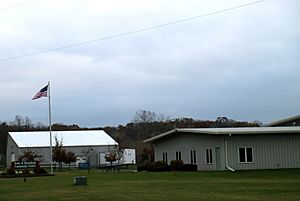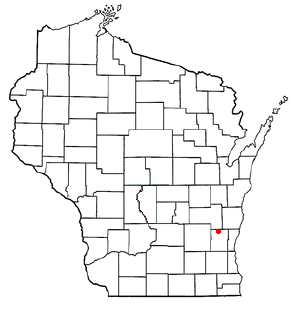Kewaskum (town), Wisconsin facts for kids
Kewaskum is a small town in Washington County, Wisconsin, United States. In the year 2000, about 1,119 people lived there. The separate community called the Village of Kewaskum is surrounded by the Town of Kewaskum. Also, a part of the community of Saint Michaels is located in the town.
Contents
How Kewaskum Got Its Name
Kewaskum was the leader of a group of Potawatomi Native Americans. They lived in Washington County in the 1840s. Chief Kewaskum was friendly with the early settlers, including Wisconsin state senator Densmore Maxon. He passed away sometime between 1847 and 1850. In 1849, the early settlers named the Town of Kewaskum (and later the village) to honor him. In the Potawatomi language, Kewaskum means "turning back on his tracks" or "retracing his steps."
History of Kewaskum
Early Days with the Potawatomi
In the early 1800s, the Kewaskum area was home to Potawatomi Native Americans. They gave up their land to the United States government in 1833 through a special agreement called the 1833 Treaty of Chicago. This treaty meant they had to leave Wisconsin by 1838. Many Potawatomis moved west, but some stayed. These were sometimes called "strolling Potawatomi." They often lived on their old lands, which were now owned by new settlers.
One group of Potawatomis traveled through different counties, led by Chief Kewaskum. He had a camp near Pike Lake. Chief Kewaskum was friendly with the white settlers who started arriving in the 1840s. He died sometime between 1847 and 1850. Native people continued to live in Washington County into the late 1800s. Many of them later moved to northern Wisconsin to form the Forest County Potawatomi Community.
First Settlers and Town Naming
The first settlers in the area were the Barnes family, who arrived in 1844. In 1847, the Wisconsin government created the Town of North Bend. This land used to be part of the Town of West Bend. The community's first post office was also set up then. In 1849, the people living there changed the town's name to Kewaskum. This was to make sure it was not confused with the nearby West Bend.
Growth of the Village
While the first settlers were mostly farmers, businesses soon followed. In 1852, J. H. Myer settled by a bend in the Milwaukee River. He built a sawmill (for cutting wood) and a gristmill (for grinding grain). This settlement was first called "Myer's Mill." It later became the Village of Kewaskum. It quickly grew into a market town with a general store and a blacksmith shop. These businesses served the local farmers.
The first church services were held in people's homes. In 1862, Catholic settlers built a church. A German Methodist church was built in 1866, and a Lutheran church in 1868. In 1873, the Chicago and North Western Railway finished a train line. It went from Milwaukee to Fond du Lac and had a station in the future Village of Kewaskum. Having a train station helped the local economy grow. New businesses like hotels, stores, and grain elevators opened near the station. The Village of Kewaskum officially became its own village in 1895.
Modern Growth and Changes
The village's population grew a lot after World War II. It doubled between 1950 and 1990. Because of this growth, the village added land from the Town of Kewaskum. This new land was used for homes and businesses. The village first added land in 1959, and many times after that. The most recent time was in 2005.
Geography of Kewaskum
The Town of Kewaskum covers about 22.8 square miles (59.0 square kilometers). Almost all of this area is land. Only a very small part, about 0.04 square miles (0.1 square kilometers), is water.
Population Information
As of the census in 2000, there were 1,119 people living in the town. This means there were about 49 people per square mile. Most of the people living in the town (99.55%) were White. A small number were Native American or from other races. About 0.18% of the population was Hispanic or Latino.
There were 394 households in the town. In 36% of these homes, there were children under 18 living there. Most homes (76.1%) had married couples living together. The average household had 2.84 people, and the average family had 3.14 people.
The population was spread out by age. About 25% were under 18 years old. About 7.6% were between 18 and 24. The largest group, 29.1%, was between 25 and 44. About 26.2% were between 45 and 64, and 12.1% were 65 or older. The average age in the town was 39 years.
See also
 In Spanish: Kewaskum (condado de Washington, Wisconsin) para niños
In Spanish: Kewaskum (condado de Washington, Wisconsin) para niños



